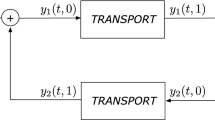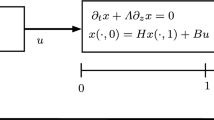Abstract
The dynamic H∞ feedback boundary control for a class of parabolic distributed parameter systems with a non-constant (spatially varying) diffusion rate is addressed in this paper. The observer-based controller is designed to deal with non-collocated sensors and actuators, and the H∞ performance index is employed to tackle the influence of the external disturbance and measurement noise. The resulting closed-loop system is formed by the boundary actuation with the H∞ control strategy, and the output feedback is designed from the domain-averaged and boundary-valued measurement, respectively. With the sufficient conditions of the linear matrix inequality that infer the stability of the system, the corresponding gains of observer and controller are solved. Numerical simulations are given to show the validity of the main results.
Similar content being viewed by others
References
B. Luo, H. N. Wu, and H. X. Li, “Adaptive optimal control of highly dissipative nonlinear spatially distributed processes with neuro-dynamic programming,” IEEE Trans. on Neural Networks and Learning Systems, vol. 26, no. 4, pp. 684–696, May 2015.
F. Logist and J. F. V. Impe, “Multiple objective optimisation of cyclic chemical systems with distributed parameters,” IFAC Proceedings Volumes, vol. 42, no. 2, pp. 295–300, 2009.
E. Cristiani, F. S. Priuli, and A. Tosin, “Modeling rationality to control self-organization of crowds: an environmental approach,” SIAM Journal on Applied Mathematics, vol. 75, no. 2, pp. 605–629, January 2015.
H. J. Gao, W. He, C. Zhou, and C. Y. Sun, “Neural network control of a two-link flexible robotic manipulator using assumed mode method,” IEEE Trans. on Industrial Informatics, vol. 15, no. 2, pp. 755–765, February 2019.
W. He, T. T. Wang, X. Y. He, L. J. Yang, and O. Kaynak, “Dynamical modeling and boundary vibration control of a rigid-flexible wing system,” IEEE/ASME Trans. on Mechatronics, 2020. DOI: https://doi.org/10.1109/TMECH.2020.2987963
W. He, T. T. Meng, X. Y. He, and C. Y. Sun, “Iterative learning control for a flapping wing micro aerial vehicle under distributed disturbances,” IEEE Trans. on Cybernetics, vol. 49, no. 4, pp. 1524–1535, April 2019.
F. M. Han and Y. M. Jia, “Sliding mode boundary control for a planar two-link rigid-flexible manipulator with input disturbances,” International Journal of Control, Automation and Systems, vol. 18, no. 2, pp. 351–362, September 2019.
S. Salsa, Partial Differential Equations in Action From Modelling to Theory, Springer, Milan, 2008.
A. Shukla, N. Sukavanam, D. N. Pandey, and U. Arora, “Approximate controllability of second-order semilinear control system,” Circuits, Systems, and Signal Processing, vol. 35, no. 9, pp. 3339–3354, September 2016.
G. Q. Xu, “Necessary condition of linear distributed parameter systems with exact controllability,” Systems & Control Letters, vol. 118, pp. 109–115, August 2018.
S. Rudy, A. Alla, S. L. Brunton, and J. N. Kutz, “Data-driven identification of parametric partial differential equations,” SIAM Journal on Applied Dynamical Systems, vol. 18, no. 2, pp. 643–660, January 2019.
J. Chen, B. Jiang, and J. Li, “Missing output identification model based recursive least squares algorithm for a distributed parameter system,” International Journal of Control, Automation and Systems, vol. 16, no. 1, pp. 150–157, February 2018.
X. Lou and B. Cui, “Adaptive consensus filters for second-order distributed parameter systems using sensor networks,” Circuits, Systems, and Signal Processing, vol. 34, no. 9, pp. 2801–2818, September 2015.
M. A. Demetriou, “Spatial PID consensus controllers for distributed filters of distributed parameter systems,” Syst. Contr. Lett. vol. 63, pp. 57–62, January 2014.
Y. Jiang, C. Liu, Q. L. Zhang, and T. Y. Zhao, “Two side observer design for singular distributed parameter systems,” Systems & Control Letters vol. 124, pp. 112–120, February 2019.
W. Kang and E. Fridman, “Boundary constrained control of delayed nonlinear schrödinger equation,” IEEE Trans. on Automatic Control, vol. 63, no. 11, pp. 3873–3880, January 2018.
M. Raissi, P. Perdikaris, and G. E. Karniadakis, “Physics-informed neural networks: A deep learning framework for solving forward and inverse problems involving nonlinear partial differential equations,” Journal of Computational Physics, vol. 278, pp. 686–707, February 2019.
M. Hamidaoui, C. Shao, and S. Haouassi, “A PD-type iterative learning control algorithm for one-dimension linear wave equation,” International Journal of Control, Automation and Systems, vol. 18, no. 4, pp. 1045–1052, 2020.
Y.-H. Lan, J.-J. Xia, Y.-P. Xia, and P. Li, “Iterative learning consensus control for multi-agent systems with fractional order distributed parameter models,” International Journal of Control, Automation and Systems, vol. 17, no. 11, pp. 2839–2849, November 2019.
D.-X. Zhao, J.-J. Wang, and Y.-P. Guo, “The direct feedback control and exponential stabilization of a coupled heat PDE-ODE system with Dirichlet boundary interconnection,” International Journal of Control, Automation and Systems, vol. 17, no. 1, pp. 38–45, January 2019.
K.-S. Hong and J. Bentsman, “Direct adaptive control of parabolic systems: Algorithm synthesis, and convergence and stability analysis,” IEEE Trans. on Automatic Control, vol. 39, no. 10, pp. 2018–2033, October 1994.
K.-S. Hong and J. Bentsman, “Application of averaging method for integro-differential equations to model reference adaptive control of parabolic systems,” Automatica, vol. 30, no. 9, pp. 1415–1419, September 1994.
L.-S. Hong, “Asymptotic behavior analysis of a coupled time-varying system: Application to adaptive systems,” IEEE Trans. on Automatic Control, vol. 42, no. 12, pp. 1693–1697, December 1997.
J. Li and Y. G. Liu, “Adaptive stabilisation for a class of uncertain coupled parabolic equations,” International Journal of Control, 2019. DOI: https://doi.org/10.1080/00207179.2018.1564842
J. Li and Y. G. Liu, “Adaptive stabilization of ODE systems via distributed effect of uncertain diffusion-dominated actuator dynamics,” International Journal of Control, vol. 92, no. 1, pp. 65–76, January 2019.
J. W. Wang, “Observer-based boundary control of semilinear parabolic PDEs with non-collocated distributed event-triggered observation,” Journal of the Franklin Institute, vol. 356, no. 17, pp. 10405–10420, November 2019.
J. W. Wang, Y. Q. Liu, and C. Y. Sun, “Observer-based dynamic local piecewise control of a linear parabolic PDE using non-collocated local piecewise observation,” IET Control Theory & Applications, vol. 12, no. 3, pp. 346–358, January 2018.
Y. Q. Liu, J. W. Wang, and C. Y. Sun, “Observer-based output feedback compensator design for linear parabolic PDEs with local piecewise control and pointwise observation in space,” IET Control Theory & Applications, vol. 12, no. 13, pp. 1812–1821, September 2018.
S. Kerschbaum and J. Deutscher, “Backstepping control of coupled linear parabolic PDEs with space and time dependent coefficients,” IEEE Trans. on Automatic Control, vol. 65, no 7, pp. 3060–3067, 2020.
J. Chen, B. T. Cui, and Y. Q. Chen, “Observer-based output feedback control for a boundary controlled fractional reaction diffusion system with spatially-varying diffusivity,” IET Control Theory & Applications, vol. 12, no. 11, pp. 1561–1572, July 2018.
J. Chen, B. T. Cui, and Y. Q. Chen, “Backstepping-based boundary control design for a fractional reaction diffusion system with a space-dependent diffusion coefficient,” ISA Trans., vol. 80, pp. 203–211, September 2018.
E. Fridman and Y. Orlov, “An LMI approach to H∞ boundary control of semilinear parabolic and hyperbolic systems,” Automatica, vol. 45, no. 9, pp. 2060–2066, September 2009.
D. M. Bošković and M. Krstić, “Stabilization of a solid propellant rocket instability by state feedback,” International Journal of Robust and Nonlinear Control, vol. 13, no. 5, pp. 483–495, April 2003.
E. Fridman and A. Blighovsky, “Robust sampled-data control of a class of semilinear parabolic systems,” Automatica, vol. 48, no. 5, pp. 826–836, May 2012.
E. Fridman and N. B. Am, “Sampled-data distributed H∞ control of transport reaction systems,” SIAM Journal on Control and Optimization, vol. 51, no. 2, pp. 1500–1527, January 2013.
A. Selivanov and E. Fridman, “Delayed H∞ control of 2D diffusion systems under delayed pointlike measurements,” Automatica, vol. 109, 108541, November 2019.
J. W. Wang, H. N. Wu, and C. Y. Sun, “Local exponential stabilization via boundary feedback controllers for a class of unstable semi-linear parabolic distributed parameter processes,” Journal of the Franklin Institute, vol. 354, no. 13, pp. 5221–5244, September 2017.
H. N. Wu, J. W. Wang, and H. X. Li, “Exponential stabilization for a class of nonlinear parabolic PDE systems via fuzzy control approach,” IEEE Trans. on Fuzzy Systems, vol. 20, no. 2, pp. 318–329, October 2012.
W. A. Hadad, D. Maillet, and Y. Jannot, “Modeling unsteady diffusive and advective heat transfer for linear dynamical systems: A transfer function approach,” International Journal of Heat and Mass Transfer, vol. 115, pp. 304–313, December 2017.
A. Pisano and Y. Orlov, “Boundary second-order slidingmode control of an uncertain heat process with unbounded matched perturbation,” Automatica, vol. 48, no. 8, pp. 1768–1775, August 2012.
A. Baccoli, Y. Orlov, A. Pisano, and E. Usai, “Sliding-mode boundary control of a class of perturbed reaction-diffusion processes,” International Workshop on Recent Advances in Sliding Modes (RASM), Istanbul, Turkey, pp. 1–6, July 2015.
A. Cristofaro, “Robust tracking control for a class of perturbed and uncertain reaction-diffusion equations,” IFAC Proceedings Volumes, vol. 47, no. 3, pp. 11375–11380, August 2014.
S. J. Ho and B. S. Chen, “Robust fuzzy H∞ estimator-based stabilization design for nonlinear parabolic partial differential systems with different boundary conditions,” IEEE Trans. on Fuzzy Systems, vol. 24, no. 1, pp. 208–222, July 2016.
M. Chinnamuniyandi, R. Ramachandran, J. Cao, G. Rajchakit, and X. Li, “A new global robust exponential stability criterion for H∞ control of uncertain stochastic neutral-type neural networks with both timevarying delays,” International Journal of Control, Automation and Systems, vol. 16, no. 2, pp. 726–738, April 2018.
R. F. Curtain and H. Zwart, An Introduction to Infinite-dimensional Linear Systems Theory, Springer, New York, 1995.
P. G. Hardy, J. E. Littlewood, and G. Pólya, Inequalities, Cambridge University Press, Cambridge, UK, 1934.
Author information
Authors and Affiliations
Corresponding author
Additional information
Publisher’s Note Springer Nature remains neutral with regard to jurisdictional claims in published maps and institutional affiliations.
Recommended by Associate Editor Wei He under the direction of Editor-in-Chief Keum-Shik Hong. This work is supported by China Postdoctoral Science Foundation (2018M642160) and the 111 Project (B12018).
Yanjiu Zhou received her Bachelor’s degree in electric information engineering from Nanjing Forestry University, Nanjing, China, in June 2016. From September 2016, she is pursuing a Ph.D. degree at Jiangnan University. She is currently a Joint Training Ph.D. Student at the Department of Chemical & Materials Engineering, University of Alberta, from June 2019. Her research interests include distributed parameter systems, boundary control, robust control and stability of dynamical systems.
Baotong Cui received his Ph.D. degree in control theory and control engineering from the College of Automation Science and Engineering, South China University of Technology, China in July 2003. He was a post-doctoral fellow at Shanghai Jiao-Tong University, China, from July 2003 to September 2005, and a visiting scholar at the Department of Electrical and Computer Engineering, National University of Singapore, Singapore, from August 2007 to February 2008. He became an associate professor in December 1993 and a full professor in November 1995 at the Department of Mathematics, Binzhou University, China. He joined Jiangnan University, China in June 2003, where he is a full professor for the School of IoT Engineering. His current research interests include systems analysis, control of distributed parameter systems, stability of dynamical systems, artificial neural networks, and chaos synchronization.
Xuyang Lou received his Ph.D. degree in control theory and control engineering from Jiangnan University, Wuxi, China, in 2009. In 2010, he joined the School of Communication and Control Engineering, Jiangnan University. From October 2007 to October 2008, he was a visiting scholar in the CSIRO Division of Mathematical and Information Sciences, Adelaide, Australia. From July to November 2010, he was a Postdoctoral Fellow in the Department of Electrical Engineering (ESAT-SCDSISTA), Katholieke Universiteit Leuven. From July 2014 to February 2015, he visited the Computer Engineering Department, University of California, Santa Cruz, USA. He is currently a Professor with Jiangnan University. His current research interests include hybrid systems, distributed parameter systems and computational intelligence.
Rights and permissions
About this article
Cite this article
Zhou, Y., Cui, B. & Lou, X. Dynamic H∞ Feedback Boundary Control for a Class of Parabolic Systems with a Spatially Varying Diffusivity. Int. J. Control Autom. Syst. 19, 999–1012 (2021). https://doi.org/10.1007/s12555-019-0926-3
Received:
Revised:
Accepted:
Published:
Issue Date:
DOI: https://doi.org/10.1007/s12555-019-0926-3




